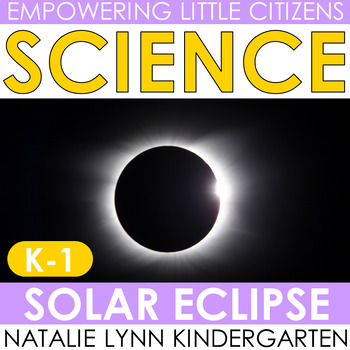Solar Eclipse 2024 Kindergarten + 1st Grade Science Lesson Crafts Drawing Crown
26,959 Downloads
Natalie Lynn Kindergarten
31k Followers
Grade Levels
K - 1st
Subjects
Resource Type
Standards
NGSS1-ESS1-1
Formats Included
- Zip
- Google Apps™
Pages
40 pages
Natalie Lynn Kindergarten
31k Followers

Includes Google Apps™
The Teacher-Author indicated this resource includes assets from Google Workspace (e.g. docs, slides, etc.).
Also included in
- The Empowering Little Citizens Kindergarten Science Curriculum includes everything you need for a meaningful science block in Kindergarten (and first grade too)! Science digital teaching slides are also included for a less prep teaching option.These units are not marked with a grade level so you arePrice $30.00Original Price $94.00Save $64.00
Description
Get ready for the Solar Eclipse 2024 with a FREE science lesson activities for Kindergarten or First Grade! This lesson is a sample of my Kindergarten + First Grade Science Curriculum for the Year.
Hands-on and engaging science lessons have never been easier! In this lesson on solar eclipses, students will explore what a solar eclipse is. This lesson includes everything you need from a full lesson plan to crafts to worksheets and more!
Love this lesson? SAVE BIG with the Science Curriculum for the Year BUNDLE!
Includes Science digital teaching slides for a less prep option!
What is included in this science lesson:
- 1 lesson plan
- Digital teaching slides formatted for Google Slides™
- Vocabulary cards
- Differentiated student worksheets
- 3 craft options
- Solar eclipse directed drawing
- Solar eclipse crown
Total Pages
40 pages
Answer Key
N/A
Teaching Duration
N/A
Report this resource to TPT
Reported resources will be reviewed by our team. Report this resource to let us know if this resource violates TPT’s content guidelines.
Standards
to see state-specific standards (only available in the US).
NGSS1-ESS1-1
Use observations of the sun, moon, and stars to describe patterns that can be predicted. Examples of patterns could include that the sun and moon appear to rise in one part of the sky, move across the sky, and set; and stars other than our sun are visible at night but not during the day. Assessment of star patterns is limited to stars being seen at night and not during the day.






